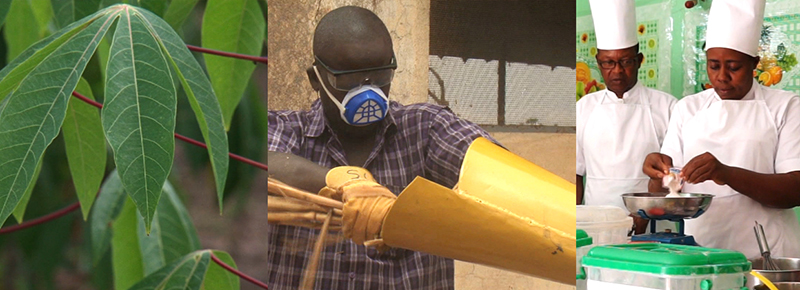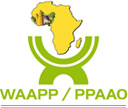
Senegal 25 January 2018 /
With dwindling aid to tackle a growing list of problems in developing countries, working in isolation to address challenges of similar nature is no longer an option.
For the International Institute for Tropical Agriculture (IITA), who have been mandated to implement a new technologies adoption program known as the Technologies for Africa’s Agriculture Transformation (TAAT), working collaboratively with other partners is obviously the right thing to do if the expected results are to be achieved.
IITA is the main implementing agency of TAAT funded by the African Development Bank (AfDB) while CORAF is the main implementing agency of the West Africa Agricultural Transformation Program (WAATP). The World Bank funds the latter and it goes operational at the end of 2018.
“Our expectation is basically to see how we can work together to deliver collaboratively rather than competitively,” says Dr. Chrysantus Akem, Program Manager of TAAT at IITA.
In mid-November, Dr. Chrysantus Akem participated in a meeting to develop the new West Africa Transformation Program (WAATP) at a workshop of major partners in Abidjan, Cote d’Ivoire. CORAF communications team sat down with the IITA official. In the following interview, he provides insights on how he views the potential partnership with CORAF and other national, regional, and international partners. Read on:
CORAF: First of all, what is TAAT?
Dr. Chrysantus Akem: TAAT is the Technologies for African Agriculture Transformation. It was formulated by the AfDB to take to scale technologies that have been designed by the CGIAR and national agricultural research centers to transform agriculture in Africa.
CORAF: How did IITA become a leading implementing body of this program?
Dr. Chrysantus Akem: Basically, IITA was approached by the AfDB to take a lead role in implementing this program. It was based on the achievements of the Support to Agricultural Research for Development of Strategic Crops in Africa (SARD-SC). This was a five-year program funded by the AfDB. The excellent results produced by the program convinced the AfDB that IITA could take on a greater role in TAAT.
CORAF: Excellent. We understand working on a partnership with other national and regional research institutions is central to the delivery approach of TAAT. We also understand you are looking to work together with the WAATP. Could you tell us concretely what do you expect from the CORAF, the main implementing body of the WAATP?
Dr. Chrysantus Akem: After SARD-SC ended, we intended to go to phase two. Then suddenly we realized phase II was essentially about expanding the program to scale out the technologies that were created. When the AfDB decided that TAAT will be one of the pillars of Feed Africa, one of the five strategic priority areas of the AfDB, we realized that it mirrored what we intended to do in SARD-SC II. So, we obviously came on board and decided to expand the program not only to focus on four commodities but as many commodities as the national constituents wanted. This was the initial intent. Thirty-five countries who participated in the first workshop expressed interest in being part of TAAT. Eighteen value chains were selected during the workshop as primary areas of focus. After a series of meetings, we all narrowed down to what they wanted. At the same time, we realized that the World Bank-funded West Africa Productivity Program (WAAPP) was doing the same thing. The timing couldn’t be more right more right. We all understood that the transformation of Africa’s agriculture was our focus. This is how we started to think alike. So, the President of the AfDB approached the President of World Bank and then suggested that these two programs should work together collaboratively in other to transform agriculture in Africa. That set the scene of the collaboration between IITA, lead implementing agency of TAAT and the CORAF who are implementing the World Bank’s WAAPP. That is where we started this collaboration. Our expectation is basically to work together to deliver collaboratively rather than competitively. We want to see how we can transform the silos in which we have been researching as different institutions and regions and do it together and collaboratively to transform agriculture in Africa. I believe this is a unique opportunity to change, and we have to do it, and I hope that we can do it this time around.
CORAF: Are there some areas of collaboration that you have already identified?
Dr. Chrysantus Akem: Yes. We had a couple of meetings in which areas of collaboration were identified.
CORAF: Can you name a few?
Dr. Chrysantus Akem: The one that stands out is varietal transformation. Each of the commodities has target varieties selected either because of yield or because of adaptation which they want to take to scale. This is a good opportunity because this is one technology that stands out across. The second one is mechanization. We all know that we cannot transform agriculture in Africa by using the hoe and cutlass. Some people have jokingly said, the hoe and cutlass need to belong to the museum and we need to focus on mechanization. How can we look at those mechanization options – be they production or post-harvest that we can focus on to transform agriculture in Africa? Processing is also central to what we are looking at. We want to look at it as a value chain. So, the technology that we are focusing on is from production right to the end consumers. Those are the two keys areas that we want to look at, and that happens to be the same focus of the WAATP. The WAAPP looks at technology along the value chain. At IITA and CGIAR, we have been working on selecting varieties that are high yielding, adapted, resistant to all different pests and diseases, and we feel we have technologies to quickly transform some of these varieties so that we can get that maximum yields or achieve the required transformation during a short period. We are ready to take some of these techniques to scale. Take for example; if you take one hectare of cassava, you can multiply material and plant 10 hectares. We have methods that can increase that 100 times in less than a year and be able to have enough material to plant one hundred times what you started with. Those are the kind of technologies that we have ready to go regarding transforming the technologies on cassava. If we take yam as another example, we have devised techniques where we can use the vines of yam to produce a tuber and again that can multiply a hundredfold more than we can do now. So, there are some technologies that IITA has ready to go, and we are ready to share some of these techniques with the other countries so that we can rapidly transform agriculture under the joint WAAPP, TAAT collaboration.
CORAF: You just talk about silos; how do you plan to work with national and regional agricultural research systems across Africa to take to scale technologies and achieve expected results?
Dr. Chrysantus Akem: To break the silos, we need to start planning together. Now is the time to plan together with all partners. Right now, we have the AfDB and the World Bank. Both donors want to make a difference. CORAF and IITA are the two implementing agencies. To be effective, we have to brainstorm and develop our priorities together. Incidentally, IITA and CORAF have similar partners at national and regional levels. So, if we do the preliminary plan on how we can take this to scale and then engage the national partners and work out modalities, it can make a difference. More importantly, national partners need to come on board because we want this to be sustainable time around. We want TAAT to be owned by national partners.
CORAF: And talking about sustainability, both TAAT and WAATP will end at some point. How to do you ensure countries take ownership of these programs and put in place lasting arrangements?
Dr. Chrysantus Akem: Yes. Planning is an aspect we need to build into the program from the design phase. Past programs have attempted to do that, but they may not have been very effective. But we need to do that this time around in a way that we get a commitment from national partners. One of the ways to secure country commitment is through counterpart funding. What this means is getting national partners to not only partner but also bring in their own contribution. This means providing personnel, land, and other infrastructure such as laboratories so that it becomes a continuous program. And we also want to ensure that countries build this into the planning processes of the national agriculture programs. This way, you do not have a differentiation between national and international programs. If this planning becomes a yearly affair where the technical and policy personnel of national governments are systematically involved, this will lead to complete buy-in and commitment. With this approach, we believe that is can actually be sustainable even when we start to withdraw.
CORAF: We always end this conversation by asking you one very individual question. You have been on the development scene for a very long time, as we begin to plan this critical program for the west and central regions, do you have any major concern?
Dr. Chrysantus Akem: Yes. My concern is that of fulfilling commitments. The Malabo declaration stipulated that countries will invest at least 10 percent of their national budgets on agriculture. From what we know, there are only a few countries that have met that commitment, and very few others have made it up to five percent. So, my concern is we need to stop talking and act. The African government needs to measure commitment by what they do and not just what they talk because time has come where we need to go beyond talking and start doing.
CORAF: Thank you very much for speaking to us. We appreciate your time.
Dr. Chrysantus Akem: Thank you very much. It is my pleasure. I hope, and I look forward a solid collaborative working relationship between IITA and CORAF.
Below is the full audio interview







